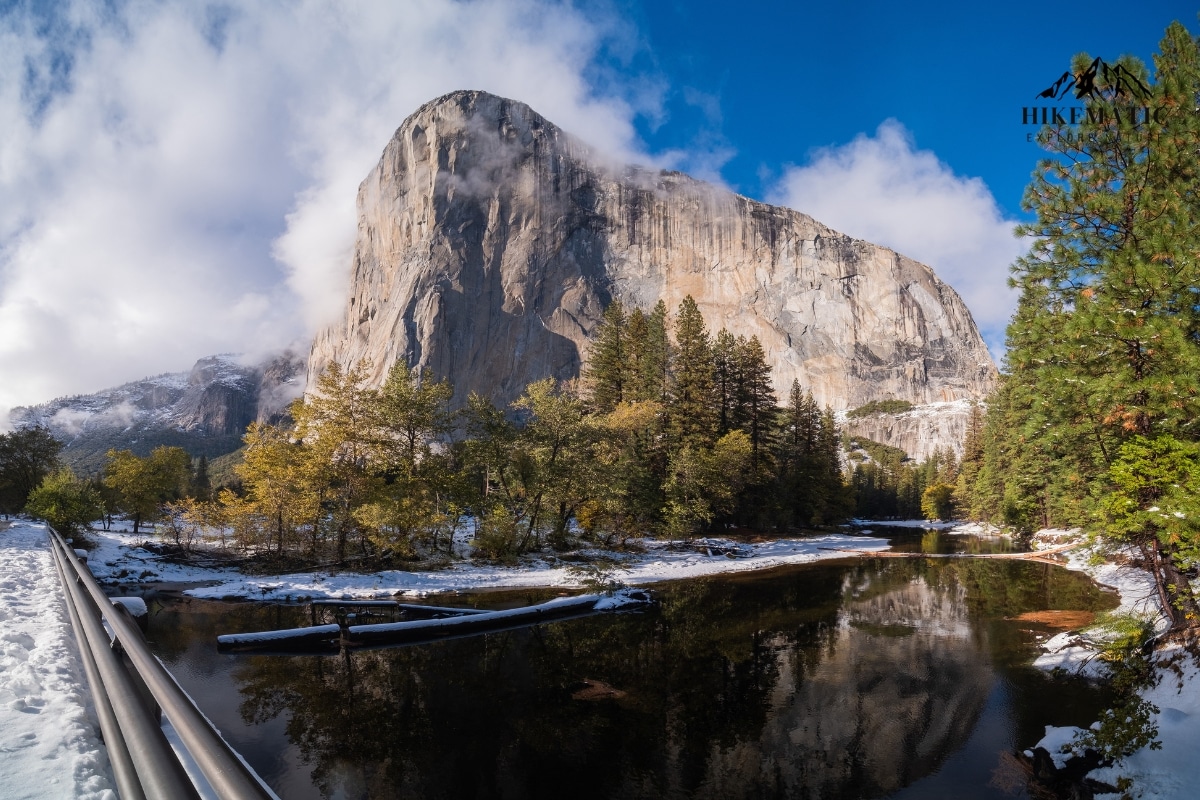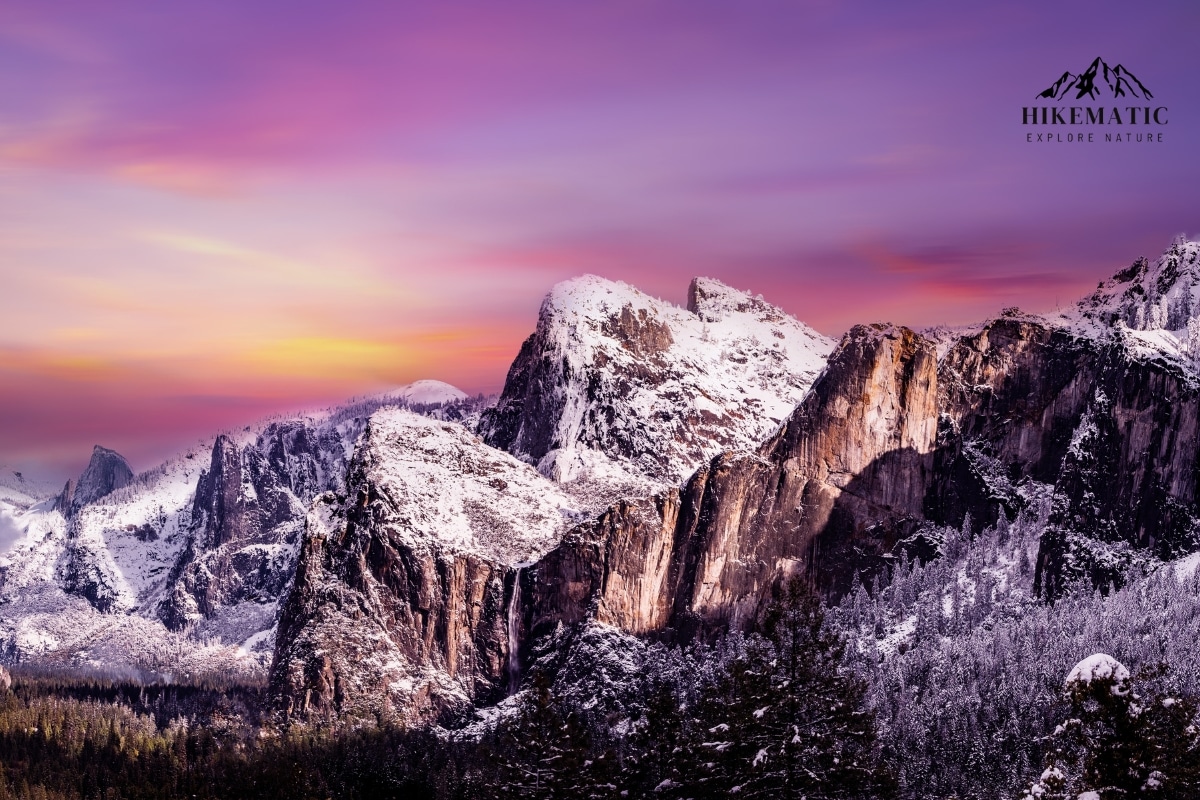Stepping into Yosemite National Park in the winter is truly magical. Usually crowded paths become quiet, snow-covered landscapes. Standing at Yosemite Valley’s edge, the stillness felt almost surreal.
The granite cliffs, sprinkled with snow, stood against clear blue skies. This view takes your breath away. This hike is more than a walk; it’s a deep dive into peace.
Do you feel overwhelmed by the buzz of daily life? Winter hiking in Yosemite offers a chance to find calm. The park’s quietness in winter is unmatched. With each step crunching in the snow, the frozen waterfalls become unforgettable sights. I felt a deep peace, reminding me of Yosemite’s timeless beauty.
Why winter hiking in Yosemite National Park is a must-do experience
When winter arrives, Yosemite National Park turns into a magical place. It’s ideal for hikers who love beauty, quiet, and fewer people. The snow makes everything peaceful and different from busy summer times.
The unique beauty of snow-covered landscapes
Seeing Yosemite’s famous cliffs and valleys covered in snow is unforgettable. Snow contrasts with granite cliffs in a unique way. Each step shows you amazing views that are both peaceful and grand. Winter adds sparkle and sharpness to Yosemite’s natural beauty.
Fewer Crowds
In winter, Yosemite is quieter and less crowded. This lets you get closer to nature. With fewer people, you can see more wildlife and enjoy the quiet forests. It’s easier to enjoy Yosemite’s beauty without summer’s noise.
Peaceful Atmosphere
Winter hikes in Yosemite are very peaceful. The quiet, snowy trails make you think and enjoy solitude. The snow makes quiet sounds, and the air is crisp. It’s perfect for relaxing and finding peace away from daily life.
Getting ready for your winter hike
Planning a winter hike in Yosemite National Park calls for careful preparation. It’s important to have the right warm clothes, gear, and know-how to keep safe. This ensures you enjoy the park’s snowy beauty to the fullest.
Warm clothing and layers
For a winter hike, layering your clothes is key. Start with a base layer that wicks away sweat. Then, add an insulating layer, such as fleece, to keep warm. Finish with a waterproof shell for protection. Remember hats, gloves, and balaclavas for your skin.
Essential Gear for Winter Hiking
The right gear makes a big difference. You’ll need waterproof boots, microspikes or snowshoes, and trekking poles. Tougher trails may require the use of an ice axe. Don’t forget a map, compass, GPS, extra clothes, food, water, and a first aid kit.
Safety Tips
Your safety is the most important thing. Before you go, check the weather and prepare for avalanches. Learn about hypothermia and frostbite.
Plan to get back before it’s dark, and let someone know your plans. A personal locator beacon adds safety.
With adequate preparation, a winter hike in Yosemite can be amazing. The right clothes, gear, and safety tips are crucial. They help you safely explore this winter wonderland.
Yosemite’s Top Winter Hiking Trails
Yosemite’s winter landscapes are something you won’t want to miss. There are several top hikes with amazing views and peaceful vibes. Let me show you some of the best trails.
Dewey Point
Dewey Point is a top pick for winter hikes. You start at the Badger Pass Ski Area and trek 7.2 miles in total. The views of Yosemite Valley and El Capitan from here are just stunning. It’s a moderate hike, so it’s a little challenging but enjoyable.

Glacier Point Road
The Glacier Point Road offers a unique winter hiking experience. In the winter, it’s a quiet path for skiing and snowshoeing. With no cars, the trail is calm, showing beautiful scenes. Starting from Badger Pass, the journey rewards you with views of Half Dome and more. It’s a bit long, but truly worth it.
Mariposa Grove of Giant Sequoias
A trip wouldn’t be complete without seeing the Mariposa Grove of Giant Sequoias. It feels magical to walk among snow-covered giants. It’s an effortless 2-mile hike to the Grizzly Giant and California Tunnel Tree. The giant sequoias look majestic against the snow, providing a peaceful hike.
Exploring the Valley Loop Trails
The Valley Loop Trails in Yosemite are a wonderful way to see the valley’s beauty in winter. They offer a mix of straightforward walks and tougher paths. You’ll see stunning views, like snow-covered cliffs, as you hike.
These trails have something for everyone. You can enjoy a calm walk or go on a more challenging hike. Look out for animal tracks in the snow. The quiet of winter makes the hike even more special.
If you want a longer hike, the full loop lets you see more of Yosemite. There are paths for all, whether you’re new to hiking or very experienced. The trails are a wonderful chance to take amazing photos of Yosemite.
Planning a winter hike? Add the Valley Loop Trails to your list. They have simple and moderate paths, offering stunning winter views of Yosemite. Get your boots ready, dress warmly, and enjoy the magic of these trails.
The Badger Pass Ski Area offers thrilling snowshoeing adventures.
Winter in Yosemite is magical, and snowshoeing at Badger Pass Ski Area is the perfect way to see it. You can find incredible experiences here, like guided tours and special routes. These showcase the park’s unseen beauty.
Guided snowshoe tours
If you’re new to this or want a deeper experience, guided tours are perfect. They are excellent for any skill level. Experts guide you, sharing stories about Yosemite’s history, nature, and animals. At Badger Pass Ski Area, guided tours mean exploring hidden spots and learning about the park’s history and nature.
Recommended Routes
Badger Pass has snowshoeing paths for everyone. My top pick is the straightforward hike to Dewey Point, with views of El Capitan and Yosemite Valley. For those who like a challenge, try the Glacier Point Road trails. Guided or solo, these paths offer unforgettable views and peaceful snowshoeing in Yosemite’s winter wonderland.
At Tunnel View, you can catch stunning views.
In the winter, Yosemite National Park turns into a wonderland. There’s no better spot to see this magic than Tunnel View. It offers views that take your breath away. You can see El Capitan, Half Dome, and Bridalveil Fall covered in snow.
The snow-covered trees and granite giants look amazing in winter. The Tunnel View is ideal for taking photos. It’s great, whether you’re new to photography or very experienced. You can take some incredible pictures here. Here’s how to make your visit even better:
- Timing: Go at sunrise or sunset. These times provide the best lighting for snow and landscapes. Tunnel View looks its best, then.
- Equipment: Use a tripod for steady shots, especially in low light. A wide-angle lens captures more of the scene.
- Patience: Wait for when the clouds clear. The landscape’s beauty really shines through then. The changing weather adds to the views.
Each winter visit to Tunnel View is unique. It’s a must-see for its peaceful, snowy beauty. Whether you’re there to take photos or just enjoy the view, Tunnel View will touch your heart.
Experience the Mirror Lake Trail
Winter turns Yosemite’s Mirror Lake Trail into a stunning snowy paradise. It’s one of the park’s most peaceful hikes. You can really soak in the quiet beauty of nature here.
Trail Overview
The Mirror Lake Trail is suitable for everyone, no matter their hiking experience. It’s about 2 miles long and pretty flat. You’ll walk through beautiful Yosemite Valley forests before reaching Mirror Lake’s reflective waters.
What to expect
Winter hiking here is special. You might find the lake iced over, casting a giant mirror against the cliffs. The snow-covered trail is quieter than in the summer. Look for the frozen lake’s calm beauty and enjoy the quiet winter atmosphere.
You should challenge yourself on the Snow Creek Trail.
No winter hike in Yosemite matches the Snow Creek Trail’s excitement. This trail has unmatched views. But it’s one of the park’s tougher hikes.
Trail Details
The Snow Creek Trail is famous for going up over 2,600 feet. It’s a real test, even for hard-core hikers. The start is steep, and winter adds extra challenges.
But seeing Half Dome and Yosemite Valley in snow is a great reward. Each step is worth it.
Preparation and Gear
Getting ready for the Snow Creek Trail in winter is critical. Dress in top-notch, warm layers. You must have trekking poles, crampons, and solid, waterproof boots to deal with ice.
Also, check the weather and tell someone your plans. With the right prep, you’ll love tackling this challenging hike. Yosemite’s winter beauty is unbelievable.
Visit the Yosemite Valley Lodge and nearby trails
If you’re looking into winter hiking at Yosemite, the Yosemite Valley Lodge is great. It’s a top pick for both comfort and location.
Comfortable Stay
The lodge has rooms for everyone, from basic to big family spaces. You get modern comforts, cozy beds, and amazing views. After hiking, the rustic but modern vibe is just right.
Access to Popular Trails
The Yosemite Valley Lodge is close to amazing hiking spots. It’s near the Lower Yosemite Fall Trail and Cook’s Meadow Loop. You don’t need to drive far, so there’s more time for exploring.
For a cozy place and excellent trail access, the lodge is ideal for winter in Yosemite.
The Scenic Yosemite Falls Trail in Winter
Hiking the Yosemite Falls Trail in winter shows off the park’s stunning beauty. The snow-covered path offers a sharp contrast to the lush greenery of warmer months. It’s a peaceful scene that takes my breath away.
Lower and Upper Yosemite Falls
The hike begins at Lower Yosemite Falls. This location is easily accessible and showcases the waterfall, encircled by snow and ice. The cold air makes the waterfall’s sound even louder. It feels like magic.
Moving up to the Upper Yosemite Fall, the path gets tougher but more rewarding. It tests my bravery and stamina. Yet, the views along the way are worth it. The sight of the upper fall, partly frozen, with snow-covered cliffs in the back is unforgettable.
Snow-Covered Beauty
The snow changes the whole look of the Yosemite Falls Trail. It offers a unique view that’s difficult to find anywhere else. The snow makes everything quiet, with only the sound of flowing water breaking the silence. The trek feels almost magical.
Winter changes how I see the Yosemite Falls Trail. I am amazed by the mix of rugged beauty and calm quiet. This winter hike is about both the journey and the destination. It’s filled with stunning views and the soothing sound of water.
Are Winter Hikes in Yosemite Comparable to Top Winter Hikes in the Alps?
Winter hikes in Yosemite offer a serene beauty comparable to unforgettable alpine winter hiking trails. The snow-kissed landscapes, towering granite cliffs, and tranquil valleys create a magical atmosphere. While the Alps boast their own allure, Yosemite’s unique charm and breathtaking vistas provide an equally captivating experience for winter adventurers.
Conclusion
Yosemite National Park’s breathtaking beauty draws us in during the winter. Winter in this famous park mixes peace with thrilling challenges. You might like the snow, the silence, or fewer people. Each path offers a special winter hiking adventure.
When heading out into the cold, make sure you’re ready. You need warm clothes, the right gear, and safety tips. There are many beautiful trails to see, like Dewey Point and the road to Glacier Point. For something different, try snowshoeing at Badger Pass or enjoy the views at Tunnel View. Each has its own winter wonder.
Yosemite is a top spot for winter hiking. Staying at the Yosemite Valley Lodge makes it simple to hit the trails. Don’t miss seeing Lower and Upper Yosemite Falls or the tranquility of the Mirror Lake Trail. Get your winter gear, be ready for the cold, and discover Yosemite’s unique winter beauty.

